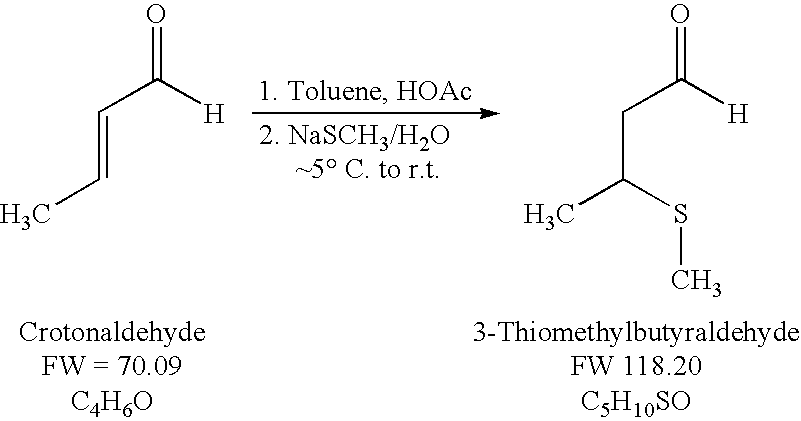Process for the addition of thiolates to ?,?-unsaturated carbonyl or sulfonyl compounds
a technology of thiolates and carbonyl or sulfonyl compounds, which is applied in the preparation of carbonyl compounds, organic chemistry, chemistry apparatus and processes, etc., can solve the problems of difficult to obtain high purity alkylthio substituted aldehyde starting materials
- Summary
- Abstract
- Description
- Claims
- Application Information
AI Technical Summary
Benefits of technology
Problems solved by technology
Method used
Image
Examples
example 1
Preparation of 3-Thiomethylbutyraldehyde
[0022]
[0023]Crotonaldehyde (21.06 grams (g), 0.30 moles), toluene (170 milliliters (mL)) and glacial acetic acid (34.4 mL, 0.60 moles (mol), 2.0 equivalents (eq)) were combined in a 500 mL three necked round bottomed flask equipped with a magnetic stir bar, thermowell with K-thermocouple, pressure equalizing addition funnel, nitrogen oil bubbler and septum. The reactor system was vented to a bleach scrubber. The clear, colorless solution was chilled in an ice bath to less than 5° C. A 15 wt % aqueous solution of sodium thiomethoxide (168.53 g of solution, 25.28 g, 0.361 mol, 1.2 eq) was added dropwise via the addition funnel during 44 minutes (min). The starting temperature was 1.4° C. The final temperature was 3.7° C. The maximum temperature realized during the addition was 4.3° C. Stirring was continued at less than 5° C. for 1 hour (h) 26 min. The ice bath was drained and the reaction mixture allowed to warm to room temperature and stirred ...
example 2
Preparation of 3-Thiomethylbutyraldehyde
[0024]
[0025]To a two-neck 25 mL round bottom flask equipped with a temperature probe, magnetic stirring, and bleach scrubber was charged in sequence 1.45 g (24.17 millimoles (mmol)) of glacial acetic acid followed by 1.44 g (20.55 mmol) of crotonaldehyde followed by 4.0 mL of acetonitrile, and the mixture was then cooled in an ice-water bath. To this mixture was continuously added (con-added) 10 g (21.40 mmol) of a 15 wt % sodium thiomethoxide in water solution over a 13 min period. The internal reaction temperature rose from 2° C. to 11° C. during the sodium thiomethoxide addition. The ice-water bath was removed and the reaction mixture was allowed to warm to ambient temperature and stirred for an additional 32 min. The reaction mixture was then heated at 50-60° C. for 3 h at which time GC analysis indicated the reaction was complete. After cooling to ambient temperature, the organic layer was separated. The aqueous layer was extracted with 2...
example 3
Preparation of 3-Thiomethylbutyraldehyde
[0026]
[0027]To a three-neck 100 mL round bottom flask equipped with a temperature probe, magnetic stirring, and bleach scrubber was charged in sequence 3.71 g (61.78 mmol) of glacial acetic acid followed by 3.62 g (51.65 mmol) of crotonaldehyde followed by 10 mL of toluene, and the mixture was then cooled in an ice-water bath. To this mixture was con-added 25 g (53.50 mmol) of a 15 wt % sodium thiomethoxide in water solution over a 21 min period. The internal reaction temperature rose from 2° C. to 10° C. during the sodium thiomethoxide addition. The ice-water bath was removed and the reaction mixture was allowed to warm to ambient temperature and stirred for an additional 23 min. The reaction mixture was then heated at 50-60° C. for 4.5 h at which time GC indicated the reaction was complete. After cooling to ambient temperature, the organic layer was separated. The aqueous layer was extracted with 2.5 mL of fresh toluene. The combined organic...
PUM
 Login to View More
Login to View More Abstract
Description
Claims
Application Information
 Login to View More
Login to View More - R&D
- Intellectual Property
- Life Sciences
- Materials
- Tech Scout
- Unparalleled Data Quality
- Higher Quality Content
- 60% Fewer Hallucinations
Browse by: Latest US Patents, China's latest patents, Technical Efficacy Thesaurus, Application Domain, Technology Topic, Popular Technical Reports.
© 2025 PatSnap. All rights reserved.Legal|Privacy policy|Modern Slavery Act Transparency Statement|Sitemap|About US| Contact US: help@patsnap.com



